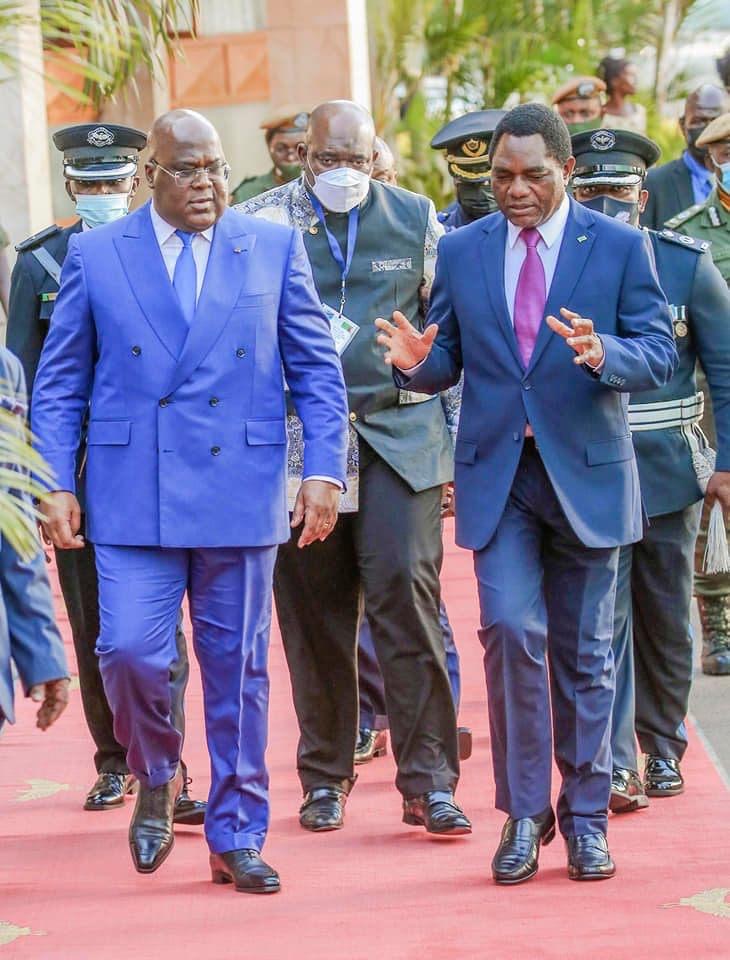Ranked almost at par with geopolitics, climate change is a key threat that the world faces for which decarbonization efforts to preserve the planet have intensified. If no urgent action is taken the world stands to lose 10% ($23trillion) of gross domestic product by 2050. In the labyrinth of these hurdles, Africa’s base metal producers are, like yesterday, positioning themselves for opportunity to partner in indirectly ‘carbon – sequestrating’ the environment through their natural mineral resource capital offerings such as copper and cobalt. One of the most significant efforts recorded in history, is the most recent landmark plethora of agreements that the Presidents of Africa’s top two red metal hotspots signed in Lusaka on April 29 of 2022. President Hakainde Hichilema, dubbed as Zambia’s Chief Investments Officer and the DRC leader President Felix Antione Tshilombo Tshisekedi penned value addition and transformational co-operation agreements in the electric car battery and clean energy faculties.
READ ALSO: Zambia’s copper can drive global shift to electric cars, Zanaco executive says
It is about a dry point of construction that climate risks have heightened evidenced by rising temperatures and extreme precipitation patterns manifesting in droughts affecting food and energy generation capacities. Scientific evidence points much to human induced activity especially after the industrial revolution, global leaders have in turn stepped up efforts to intervene through initiatives that will reduce greenhouse emissions significantly such as implementation of sustainable development goals. One key initiative is decarbonization through managing fossil emissions that have been cited as the biggest contributor of carbon in the ecosystem. To achieve this, many motor vehicle producers such as Ford, Tesla, BMW and Mercedes are adapting their commercial strategies to mitigating against a morphing risk landscape so as to remain competitive, compliant and help towards preserving the planet. The electric motor car era has come and will require mineral resources such as copper, cobalt and lithium to effectively produce batteries for which Africa’s Copperbelt has signaled readiness in opportunity, to tap into.
READ ALSO: DRC battery production would reduce EV emissions by 30%
The Democratic Republic of Congo and Zambia accounting for circa 80% of cobalt and 11% of copper globally have taken deliberate steps to be relevant in value addition and economic transformation to make electric battery manufacture a reality towards global climate resilience. But in so doing, the two nations will seek to simultaneously curb poverty through job creation and drive stronger economic growth. This landmark action, is a manifestation of the African Business Forum hosted by the DRC in December 2021 for which Zambia was in attendance.

Presidents Hakainde Hichilema (R) and Felix Antoine Tshisekedi (L) on arrival at Mulungushi conference centre, ahead of the protocol signing ceremony.
Speaking at the signing ceremony Hakainde Hichilema said the narrative has changed where Africa was viewed by many, only as a source of raw materials and nothing else. This the Zambian head of state said has to change, not tomorrow but yesterday. “We spoke about taking leadership for DRC, for Zambia and that no one would do it for us. We are not a threat to anyone, not to Europe, not to China nor the outside world but we have positioned ourselves as an opportunity for which we did invite people to work with us. Today we are pleased to be signing these protocols,” he said.
“Yes we want to create jobs, we want to create business opportunities, we want to fight poverty and this is the right way to fight it (poverty) an embarrassing phenomenon on our part. Such a rich continent yet riddled with poverty is unacceptable. These steps Mr. President are practical in taking out the shame out of our people who God gave so many resources. For years the continent has not taken responsibility for its own destiny. This step and many to follow should be deliberate and not by chance to change the narrative and the rest will fall in place,” Hichilema said.
Also speaking at the ceremony, the DRC head of state Felix Tshisekedi echoed that the two copper hotspots were actualizing mastership of their own destinies through driving value chains for economic transformation purposes using their resource base to promote battery production. This Tshisekedi cited as a perfect example of the need to foster economic unity that would catapult Africa’s business power through job creation and eradication of poverty significantly.
The recent global scalable surge in renewable energy demand supported by widening climate induced drought effects impacting hydro power generation coupled with efforts to phase out fossil emissions has soared demand for key base metals such as cobalt and copper. These are for use in electric power transmission and battery charge storage which has given mining a bullish outlook in the two jurisdictions. They say an average electric car needs about 80 kilograms or a mile of copper wire. The two nations are set to ramp metal production significantly over the next 5 years to a decade. For years Zambia’s weak value addition drive has been cited one of the drivers of low foreign exchange earnings and frail employment posture contributing to poverty levels that its government is actively curbing through a stronger private sector led initiative. Just a few days to protocol signing Zambia launched its first ever public private sector dialogue platform to help steer private sector led growth.

Cobalt in the hands of a miner in the DRC. Over 80% of global cobalt reserves are domiciled in DRC and Zambia.

Eleven percent (11%) of global copper deposits are mined in the Copperbelt of Africa (DRC and Zambia).
Despite being richly endowed with mineral resources in the Katanga region for DRC, political instability has robbed the mining giant of real economic benefits which its leader is changing the narrative through radical economic shifts such as joining the East African Community bloc that is opening markets and boosting trade.
FAIRLY PRICED CAPITAL KEY TO VALUE ADD AGENDA
The signed protocols do converge academia, for research into efficient production capability championing research and technology transfer and shares, while the heads of state have demonstrated leadership that creates the right economic environment for the private sector to thrive and create value but with financial partners proving ‘fairly priced’ capital. It is vivid that the two leaders have a vision however effective operationalization of the protocols will require transactions that require financing a role banks have to play. In attendance were key players such as the continents largest trade financial institution – Africa Export and Import bank and Zambia’s largest indigenous bank by asset and profitability size Zambia National Commercial Bank Plc alongside other financial institutions.
The Kwacha Arbitrageur

